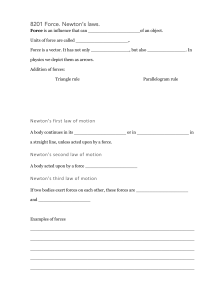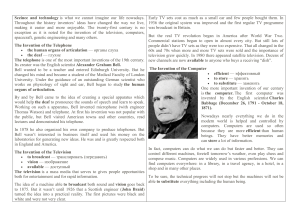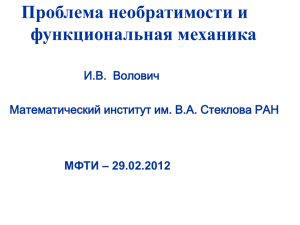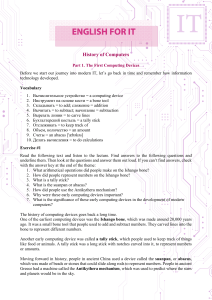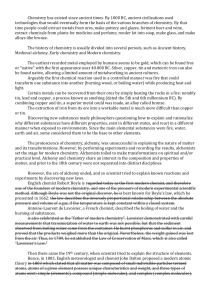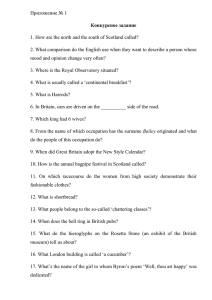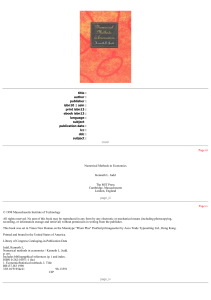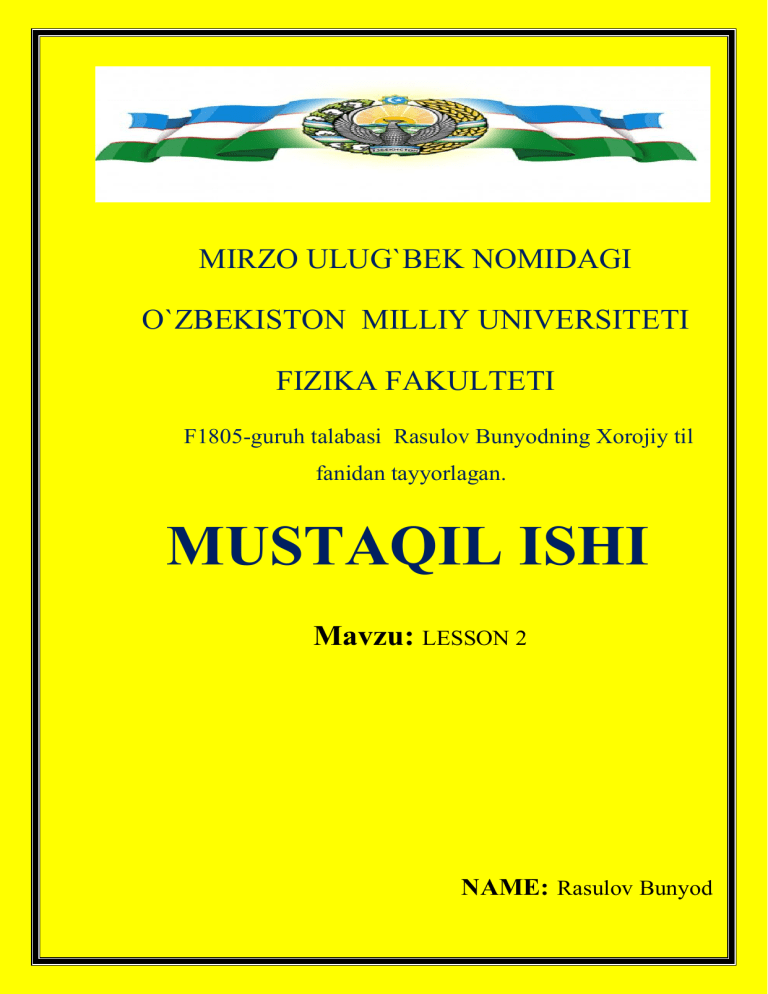
MIRZO ULUG`BEK NOMIDAGI O`ZBEKISTON MILLIY UNIVERSITETI FIZIKA FAKULTETI F1805-guruh talabasi Rasulov Bunyodning Xorojiy til fanidan tayyorlagan. MUSTAQIL ISHI Mavzu: LESSON 2 NAME: Rasulov Bunyod Lesson 24 Speaking: Famous people of Great Britain and the USA Reading: Sir Isaac Newton and Alchemy Writing: Writing a summary of a text. Grammar: Past Active and Passive Speaking: 1. Read the text and answer the questions below. Thomas Edison Thomas Edison was born in 1847. He first went to school at the age of eight and a half. But after only three months his teacher called him "stupid" and he came home crying. From that time his mother taught him at home and he read science books by himself. He got a job sending telegraph messages. Then he started inventing things. At the age of 12 he had a job selling newspapers. He made money in a clever but simple way. He checked the news stories first. When the news was interesting he took a lot of papers; when it was boring he took only few. In 1877 he made a "phonograph" — the first ever sound recorder. The following year he invented the light bulb. In 1882 New York was the first city in the world with electric lights. In 1889 he made a "kinetoscope". He also made films for his new machine. In 1903 he made the world's longest film (It was ten minutes long!) After more than one thousand inventions, Edison died at the age of eightyfour. In his honour they switched off the lights all over America. Questions: 1. Thomas Edison was born in 1847, wasn't he? Yes, he was born in 1847. 2. Why did mother teach him at home? After his teacher called him "stupid". 3. What were his inventions? In 1877 he made a "phonograph" — the first ever sound recorder. The following year he invented the light bulb. In 1882 New York was the first city in the world with electric lights. In 1889 he made a "kinetoscope". He also made films for his new machine. In 1903 he made the world's longest film (It was ten minutes long!) 4. When did Edison die? Edison died in 1891 at the age of eighty-four. 5. What did Americans do in his honour? In his honour they switched off the lights all over America. Vocabulary: to check — проверять-tekshirmoq phonograph — фонограф-fonograf(tovushni yozib oladigan va qayta eshittiradigan asbob) kinetoscope — кинескоп –kineskop(televizorning tasvir qabul qilib oladigan va ko’rsatadigan electron-nur trubkasi) to switch off — выключать-o’chirmoq 2. Speak about famous scholars of your sphere. ERNEST RUTHERFORD Ernest Rutherford went on to become one of the leading scientists of the twentieth century. He is famous for his model of the atom and for being the first person from Oceania to become a Nobel laureate by winning the NOBEL prize in Chemistry in 1908. Ernest Rutherford was born on August 30, 1871, in Nelson, New Zealand. Ernest received his early education at Government schools and entered Nelson Collegiate School at the age of 16. Rutherford married Mary Newton in 1900. Rutherford’s chief recreations were golf and motoring. He died in Cambridge, on October 19, 1937. In 1907, when Ernest Rutherford was at the age of 36, became Professor of Physics at Manchester University. Rutherford model of atom was instrumental in developing a coherent base for the development of atomic physics and nuclear physics. Ernest Rutherford remained in history with his great discoveries in physics and we still need his scientific theories today. Interesting facts about Rutherford: • The dictionary of New Zealand biography: ”the world’s first successful alchemist”. • In the words of Einstein: “a second Newton”. • A crater on the Moon and another on Mars have been named after Rutherford in his honour. • Element 104 is named Rutherfordium after him. • Reading: 1. Read the text and do the tasks below. Sir Isaac Newton and Alchemy Sir Isaac Newton is most famous for the quantification of gravitational attraction, discovering that white light is actually a mixture of immutable spectral colours, and the formulation of calculus. However it is less well documented that Newton spent 30 years engaged in the study of the mysterious art of alchemy, or as it was more commonly known then, chemistry. Only a tiny fraction of Newton’s work on alchemy has been published but he wrote around a million words on the subject, including laboratory notes, indexes of alchemical substances and transcripts from other sources. On his death in 1727, Newton had over 100 manuscripts filled with alchemical material, sold by auctioneers Sotheby as part of a larger collection in 1936. This side of Newton was often an embarrassment to his admirers. His first biographer, John Conduitt, like many commentators who followed, played down the role of alchemy (and other pursuits) in Newton’s work, stating; "When he was tired with his severer studies his only relief and amusement was going to some other as History and Chronology or Divinity and Chemistry". Just how important the study of alchemy was to Newton only began to be recognised in 1947, when John Maynard Keynes, who bought much of the work from Sotheby, declared in his essay, ‘Newton, the Man’; "Newton was not the first of the age of reason. He was the last of the magicians". 2. Find Uzbek equivalents of the highlighted words in the text. quantification – kattalik, miqdor immutable – o’zgarmas, doimiy tiny fraction – kichik ulush indexes - indekslar substances - moddalar manuscripts – qo’lyozma, adimiy qo’lyozma embarrassment – to’siq, xijolat bo’lish, dovdirash amusement – o’yin-kulgu 3. Find examples of Past Active and Passive from the text and write them down. Formulas of Past Active: 𝑆 + 𝑉(𝐼𝐼) + 𝑂 + ⋯ Formulas of Past Passive: 𝑆 + 𝑤𝑎𝑠/𝑤𝑒𝑟𝑒 + 𝑉(𝐼𝐼𝐼) + 𝑂 + ⋯ 4. Write a summary of a text in 100-120 words. SUMMARY Isaac Newton is the founder of classical physics. His discoveries are still famous and we use them. His three laws are bases of mechanics. They are: NEWTON’S FIRST LAW: THE LAW OF INERTIA An object at rest or in uniform motion will remain at rest or in uniform motion unless acted on by an external force. NEWTON’S SECOND LAW The word equation for Newton’s second law is: Net force is the product of mass and acceleration. ⃗ = 𝒎𝒂 ⃗ 𝑭 NEWTON’S THIRD LAW For every action force on an object (B) due to another object (A), there is a reaction force, equal in magnitude but opposite in direction, on object A, due to object B. FA on B = −F B on A Newton’s first and second laws are sufficient for explaining and predicting motion in many situations. However, you will discover that, in some cases, you will need Newton’s third law. Newton had always been interested in the problems of light. Many people saw colours of a rainbow but only Newton showed, by his experiments, that white light consists of these colours.
